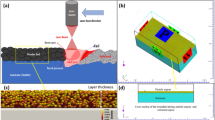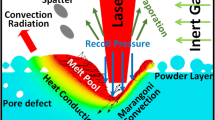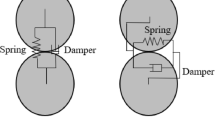Abstract
Understanding the physical mechanism of laser–powder bed fusion (LPBF) additive manufacturing can benefit significantly through computational modeling. LPBF uses a laser heat source to melt a number of layer of powder particles and manufactures a part based on the CAD design. This work aims to assess the impact of Marangoni flow, buoyancy and recoil pressure to simulate the fluid flow around melt pool with a non-Gaussian laser beam to simulate the interaction between laser and powder bed. It was observed that velocity profile shows two peaks on either side of the highest temperature point owing to Marangoni convection on both sides due to gradient in surface tension. Dimensional analysis was also conducted based on Peclet number, Nusselt number and Marangoni number to determine the mode of heat transport at various laser power/scan speed combinations. Convective heat flow is the dominant form of heat transfer at higher energy input due to violent flow of the fluid and recoil pressure around the molten region, which can also create keyhole effect associated with defects such as porosities. The computational model was also validated by comparing solidified bead geometry with experimental data.









Similar content being viewed by others
References
Ali U, Fayazfar H, Ahmed F, Toyserkani E (2020) Internal surface roughness enhancement of parts made by laser powder-bed fusion additive manufacturing. Vacuum 177:109314. https://doi.org/10.1016/j.vacuum.2020.109314
Calignano F, Manfredi D, Ambrosio EP, Iuliano L, Fino P (2013) Influence of process parameters on surface roughness of aluminum parts produced by DMLS. Int J Adv Manuf Technol 67(9–12):2743–2751. https://doi.org/10.1007/s00170-012-4688-9
Mukherjee T, Manvatkar V, De A, DebRoy T (2017) Dimensionless numbers in additive manufacturing. J Appl Phys. https://doi.org/10.1063/1.4976006
Rahman MS, Schilling PJ, Herrington PD, Chakravarty UK (2019) Thermofluid properties of Ti-6Al-4V melt pool in powder-bed electron beam additive manufacturing. J Eng Mater Technol Trans ASME 141(4):1–12. https://doi.org/10.1115/1.4043342
Masoomi M, Soltani-Tehrani A, Shamsaei N, Thompson SM (2020) Convection heat transfer coefficients for laser powder bed fusion. In: Solid Free. Fabr. 2018 Proc. 29th Annu. Int. Solid Free. Fabr. Symp. - An Addit. Manuf. Conf. SFF 2018, pp. 1686–1693
Sing SL, Yeong WY (2020) Laser powder bed fusion for metal additive manufacturing: perspectives on recent developments. Virtual Phys Prototyp 15(3):359–370. https://doi.org/10.1080/17452759.2020.1779999 (Taylor and Francis Ltd)
Mian MJ, Razmi J, Ladani L (2021) Defect analysis and fatigue strength prediction of as-built Ti6Al4V parts, produced using electron beam melting (EBM) AM technology. Materialia 16:101041. https://doi.org/10.1016/j.mtla.2021.101041
Jafari D et al (2020) Pulsed mode selective laser melting of porous structures: structural and thermophysical characterization. Addit Manuf 35:101263. https://doi.org/10.1016/j.addma.2020.101263
Ahsan F, Ladani L (2020) Temperature profile, bead geometry, and elemental evaporation in laser powder bed fusion additive manufacturing process. Jom 72(1):429–439. https://doi.org/10.1007/s11837-019-03872-3
Rahman MS, Schilling PJ, Herrington PD, Chakravarty UK (2018) A comparative study between selective laser melting and electron beam additive manufacturing based on thermal modeling. ASME Int Mech Eng Congr Expo Proc. https://doi.org/10.1115/IMECE2018-86428
Ladani L, Romano J, Brindley W, Burlatsky S (2017) Effective liquid conductivity for improved simulation of thermal transport in laser beam melting powder bed technology. Addit Manuf 14:13–23. https://doi.org/10.1016/j.addma.2016.12.004
Ladani L, Ahsan F (2019) Laser interaction with surface in powder bed melting process and its impact on temperature profile, bead and melt pool geometry. Miner Metals Mater Ser. https://doi.org/10.1007/978-3-030-05861-6_29
Li X, Zhao C, Sun T, Tan W (2020) Revealing transient powder-gas interaction in laser powder bed fusion process through multi-physics modeling and high-speed synchrotron x-ray imaging. Addit Manuf 35:101362. https://doi.org/10.1016/j.addma.2020.101362
Rahman MS, Schilling PJ, Herrington PD, Chakravarty UK (2020) Heat Transfer and Melt-Pool Evolution During Powder-Bed Fusion of Ti-6Al-4V Parts Under Various Laser Irradiation Conditions. https://doi.org/10.1115/imece2020-23838
Bikas H, Stavropoulos P, Chryssolouris G (2016) Additive manufacturing methods and modeling approaches: a critical review. Int J Adv Manuf Technol 83(1–4):389–405. https://doi.org/10.1007/s00170-015-7576-2
Shen H, Yan J, Niu X (2020) Thermo-fluid-dynamic modeling of the melt pool during selective laser melting for AZ91D magnesium alloy. Materials (Basel) 13(18):1–19. https://doi.org/10.3390/ma13184157
Zhang D, Zhang P, Liu Z, Feng Z, Wang C, Guo Y (2018) Thermofluid field of molten pool and its effects during selective laser melting (SLM) of Inconel 718 alloy. Addit Manuf 21:567–578. https://doi.org/10.1016/j.addma.2018.03.031
Bayat M, Nadimpalli VK, Mohanty S, Hattel JH (2020) Resolving the effects of local convective heat transfer via adjustment of thermo-physical properties in pure heat conduction simulation of Laser Powder Bed Fusion (L-PBF). In: IOP Conf. Ser. Mater. Sci. Eng., vol. 861, no. 1. https://doi.org/10.1088/1757-899X/861/1/012006
Chen Y et al (2020) In-situ Synchrotron imaging of keyhole mode multi-layer laser powder bed fusion additive manufacturing. Appl Mater Today 20:100650. https://doi.org/10.1016/j.apmt.2020.100650
Wang Z, Liu M (2019) Dimensionless analysis on selective laser melting to predict porosity and track morphology. J Mater Process Technol 273:116238. https://doi.org/10.1016/j.jmatprotec.2019.05.019
Rankouhi B, Agrawal AK, Pfefferkorn FE, Thoma DJ (2021) A dimensionless number for predicting universal processing parameter boundaries in metal powder bed additive manufacturing. Manuf Lett 27:13–17. https://doi.org/10.1016/j.mfglet.2020.12.002
Asakuma Y, Honda I, Yamamoto T (2019) Numerical approach to predicting the effective thermal conductivity of a packed bed of binary particles. Powder Technol 354:886–892. https://doi.org/10.1016/j.powtec.2019.07.023
Measurement and Prediction of the Thermal Conductivity of Powders at High Temperatures. https://repositories.lib.utexas.edu/handle/2152/68665. Accessed 29 Mar 29 2021
Ahsan F, Razmi J, Ladani L (2020) Experimental measurement of thermal diffusivity, conductivity and specific heat capacity of metallic powders at room and high temperatures. Powder Technol 374:648–657. https://doi.org/10.1016/j.powtec.2020.07.043
Foroozmehr A, Badrossamay M, Foroozmehr E, Golabi S (2016) Finite element simulation of selective laser melting process considering optical penetration depth of laser in powder bed. Mater Des 89:255–263. https://doi.org/10.1016/j.matdes.2015.10.002
Rauniyar SK, Chou K (2019) Melt pool analysis and mesoscale simulation of laser powder bed fusion process (L-PBF) with Ti-6Al-4V powder particles. JOM 71(3):938–945. https://doi.org/10.1007/s11837-018-3208-2
Zhang Y, Zhang J (2019) Modeling of solidification microstructure evolution in laser powder bed fusion fabricated 316L stainless steel using combined computational fluid dynamics and cellular automata. Addit Manuf 28:750–765. https://doi.org/10.1016/j.addma.2019.06.024
“What Is the Marangoni Effect?” https://www.comsol.com/multiphysics/marangoni-effect. Accessed 03 Mar 2021
“Nonisothermal Flow.” https://www.comsol.com/multiphysics/nonisothermal-flow. Accessed 03 Mar 2021
Roy U, Roy PK (2020) Advances in heat intensification techniques in shell and tube heat exchanger. In: Advanced Analytic and Control Techniques for Thermal Systems with Heat Exchangers, Elsevier, pp 197–207
Bender E (1981) Numerical heat transfer and fluid flow. VonS. V. Patankar. Hemisphere Publishing Corporation, Washington - New York - London. McGraw Hill Book Company, New York 1980. 1. Aufl., 197 S., 76 Abb., geb., DM 71,90,” Chemie Ing. Tech., vol. 53, no. 3, pp. 225–225. https://doi.org/10.1002/cite.330530323.
“Estimation of Marangoni number.” https://pirika.com/ENG/ChemEng/Marangoni.html. Accessed 26 Mar 2021
Sadowski M, Ladani L, Brindley W, Romano J (2016) Optimizing quality of additively manufactured Inconel 718 using powder bed laser melting process. Addit Manuf 11:60–70. https://doi.org/10.1016/j.addma.2016.03.006
Lee JY, Ko SH, Farson DF, Yoo CD (2002) Mechanism of keyhole formation and stability in stationary laser welding. J Phys D Appl Phys 35(13):1570–1576. https://doi.org/10.1088/0022-3727/35/13/320
Repper E (2017) Defect formation in laser welded steels after use of corrosion protection coating
Shen H, Yan J, Niu X (2020) Thermo-fluid-dynamic modeling of the melt pool during selective laser melting for AZ91D magnesium alloy. Materials (Basel) 13(18):4157. https://doi.org/10.3390/ma13184157
Wang D, Linqing L, Guowei D, Cheng D, Yuchao B, Yongqiang Y, Weihui W et al (2022) Recent progress on additive manufacturing of multi-material structures with laser powder bed fusion. Virtual Phys Prototyp 1–37
Khairallah SA, Anderson AT, Rubenchik A, King WE (2016) Laser powder-bed fusion additive manufacturing: physics of complex melt flow and formation mechanisms of pores, spatter, and denudation zones. Acta Mater 108:36–45
Mills KC (2022) Recommended values of thermophysical properties for selected commercial alloys. Woodhead Publishing
Author information
Authors and Affiliations
Corresponding author
Additional information
Publisher's Note
Springer Nature remains neutral with regard to jurisdictional claims in published maps and institutional affiliations.
Rights and permissions
About this article
Cite this article
Ahsan, F., Razmi, J. & Ladani, L. Global local modeling of melt pool dynamics and bead formation in laser bed powder fusion additive manufacturing using a multi-physics thermo-fluid simulation. Prog Addit Manuf 7, 1275–1285 (2022). https://doi.org/10.1007/s40964-022-00302-w
Received:
Accepted:
Published:
Issue Date:
DOI: https://doi.org/10.1007/s40964-022-00302-w




